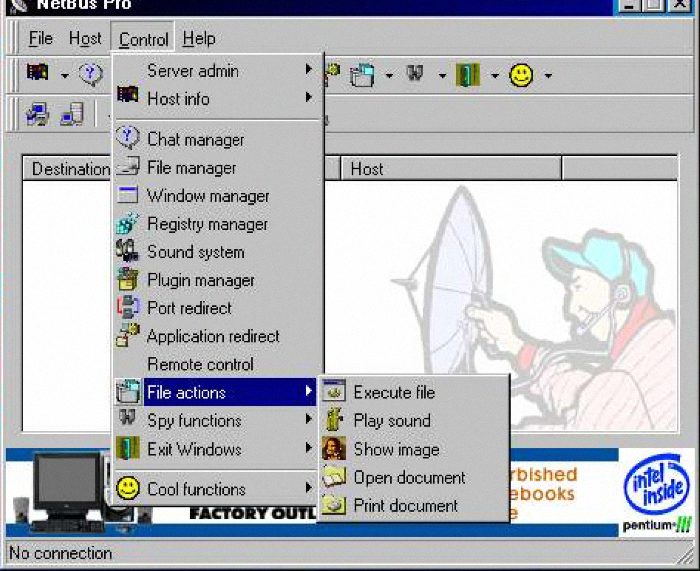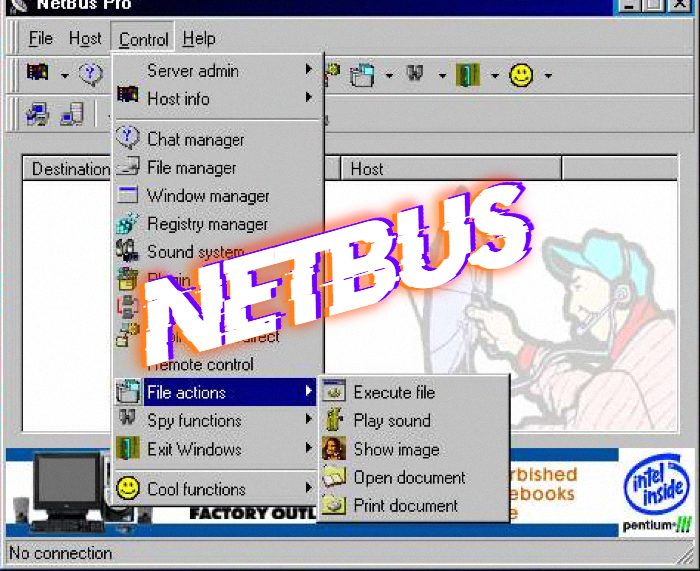What is NetBus?
NetBus has been made as a simple joke, but the ways, that it’s really used for, are harmful. Many users face this problem and don’t know what’s and how to remove NetBus from their computers. We will try to answer this question. Nowadays, specialists characterize this software as the trojan. This software is used not only to spy on the owners of the infected devices, but it’s also a Remote Access Terminal (RAT). By the means of this program hackers can use control all the operations on the infected device and get any information they want. It’s very easy to become infected with this virus, as hackers inject it into the installators. The files of the virus can hardly be differentiated from harmless ones and look like common windows programs. When the virus is in the system it uses definite ports of the device and waits for a command from the hacker’s computer. Usually it uses port 12345 or 20034 to receive the commands, but the ports can vary from version to version. NetBus 2.1 is one of the most dangerous threats, that can be found on the internet, as it can record audio from your device and microphone, shoot a video, manipulate with your files, hardware and etc. It’s very simple to imagine how it can affect your personal life and career. If you notice there is something strange with your computer, scan your device in no time. If you are definitely infected with this virus, we strongly recommend you to remove NetBus trojan with the help of our detailed guide!

Article’s Guide
- Automatic solutions for Windows
- Manual solution for Windows
- Restore Group Policy settings
- Manual solution for Google Chrome
- Manual solution for Mozila Firefox
- Manual solution for Internet Explorer
- Manual solution for Microsoft Edge
How to removeWebgamerworld.com hijacker?
Automatic solutions for Windows users
Sometimes it’s difficult to find and identify and remove such viruses as NetBus 2.1. That’s why our choice is Norton 360 . Norton 360 scans your computer and detects various threats like NetBus 2.1, then removes it with all of the related malicious files, folders and registry keys.
How to remove “NetBus 2.1” trojanmanually?
Disclaimer: You do it on your own risk. We don’t bear any responsibility for your actions. These instructions are rather large and it requires 100% precise execution.
Clean up Registry Editor
- Click on the Windows button
- Type in the search box ‘Regedit‘ and press OK
- In the menu, navigate to the: HKEY_LOCAL_MACHINE\SOFTWARE\Microsoft\Windows\CurrentVersion\Run
- Then in the right menu, remove the value ‘SysEdit‘
- Now reboot the device
- After it search for “SysEdit.exe” or “KeyHook.dll” and delete all these files
Windows
- Press the Windows button and then go to the settings menu.
- After it go to the apps menu.
- In the left side of the menu choose the sub-menu Apps & features.
- Now remote all suspicious programs.
- Then you have to clean your browser.
Restore Group Policy settings
Solution for Windows users: Sometimes viruses change your Group Policy settings that may lead to different troubles, like disability to remove the dangerous program or any other software, or it may provoke a number of errors. It’s very important to restore these settings, but be careful: you can easily damage your system.
- Open File Explorer.
- Copy and paste in the address bar the C:\Windows\System32\GroupPolicy\Machine\ address and then press Enter.
- Find registry.pol file and delete it or move to the other directory.
- Close File Explorer and press the Windows+X buttons
- Open Command Prompt (Admin) or Powershell (Admin).
- Copy and paste this command gpupdate /force and now press Enter
- Reboot your device
How to delete “NetBus 2.1” trojan from your browser?
It’s very important to clean your browser after removing the “head” of the problems. Follow the instruction and you will win this fight.
Google Chrome
- Open your browser, click on the Menu button in the upper right side of the browser (It consists of 3 dashes)
- Here choose More tools menu and then press Extensions button.
- Now look for any suspicious plugin and then press Trash button or Remove button in order to delete it (usually it’s toolbars or searching engines).
- Close the menu and click the 3-dashes button, choose Settings menu, look for Manage Search Engines button and press Manage search engines.
- Here you should look for any suspicious search site and delete it
- Close the menu and press 3-dashes button again.
- Here press Settings button and scroll down to the bottom.
- Now press Reset browser settings button, then click Reset button again to confirm this process.



 Disk Cleaner, Big Files Finder and Duplicates Scanner features are free to use. Antivirus, Privacy Scanner and Uninstaller features are paid ($39.95 for semi-anual subscription. By clicking the button, you agree to
Disk Cleaner, Big Files Finder and Duplicates Scanner features are free to use. Antivirus, Privacy Scanner and Uninstaller features are paid ($39.95 for semi-anual subscription. By clicking the button, you agree to